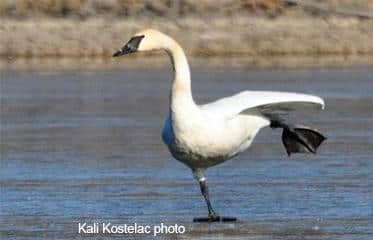Migrating Trumpeter Swans are an Impressive Sight in Kansas

Trumpeter swan sightings have been reportedly recently in several Kansas counties, including Neosho, Montgomery, Sedgwick, and Douglas. The largest species of the swan family, trumpeter swans can grow to 60 inches long and have wing spans of nearly 8 feet. These migratory water birds have reportedly been seen on several large ponds and watershed lakes, as well as agricultural fields. Although trumpeter swan sightings are becoming increasingly common, this species was once on the brink of extinction.
In the mid 1800s, market hunters nearly wiped out the species, harvesting the swans for their skins. Skins were sold to companies that then turned them into powder puffs and women’s clothing accessories. It wasn’t until restoration efforts made by states to our north that trumpeter swan numbers began to increase.
“These birds are an excellent conservation success story,” said Ed Miller, nongame biologist for the Kansas Department of Wildlife, Parks and Tourism. “They have rebounded from a population low of 73 birds in the U.S.”
Although similar in color to the other swan species native to North America, the tundra swan, the trumpeter is larger and has a distinct horn-like call, making it the loudest of all swimming birds. Tundra swans are more numerous than trumpeters, but winter along the Atlantic and Pacific coasts and are uncommon visitors in Kansas. Trumpeter swans also have all black bills, unlike tundra swans that have a distinct yellow spot on their bill.
“A 30-pound, long-necked bird with an 8-foot wingspan that moves with grace is a memorable sight,” said Miller. He added that more sightings of this bird are predicted for the near future as trumpeter swan numbers slowly increase.

